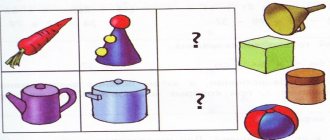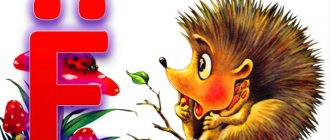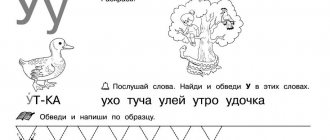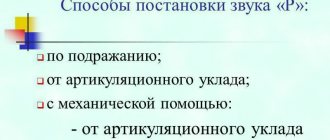Summary of the final lesson with children on learning to read and write
SOFTWARE CONTENT:
CONSOLIDATING THE PASSED MATERIAL: 1. Strengthen children’s understanding of a word and a sentence. 2. To consolidate children’s understanding of a syllable as part of a word, to practice distinguishing the number of syllables in a word by the number of vowels. 3. Develop the ability to recognize sounds and letters. 4. Clarify ideas about the essential features of vowels and consonants. 5. Summarize children’s knowledge about the hardness and softness of consonant sounds. 6. Repeat the rules for writing cha - sha, chu - schu, zhi - shi. 7. Continue to teach children to invent and add words based on a separate part of the word; train children in reading words and text. 8. Build skills in educational activities, develop cognitive interests. 9. Cultivate sustained attention, observation and desire to learn at school. EQUIPMENT: - table of syllables; — table “sound clock”; - cards with words; — pictures: cat, bus, tiger, apple, goose, boat; — cards: blue and green; - cards: wardrobe, sofa, window, chair, lamp.
Progress of the lesson:
Educator: Children, yesterday I received a huge letter, guess who sent it? D.: Dunno! V.: Yes, this is Dunno. He sent an unusual letter, but a letter with tasks and questions that he himself could not answer. And asks you for help. I hope we will not refuse and will try to complete all the tasks that Dunno sent us (on the board there is a portrait of Dunno and an envelope with tasks).
Task No. 1. “Find the word”
V.: The hut in which the watchman lives? D.: Guard! Q: Decoration in the ears? D.: Sergius! Q: Is there a solid clasp on the belt? D.: Buckle! Q: Part of a table or chair? D.: Leg! V.: Children, what did we call you? D.: Words. V.: Children, let's read what is written on the board (read). What have we read again? D.: Words. V.: Okay. Now let's see what is written on the board: “Early spring has come.” What have we read? D: This is a proposal. Q: What does our offer consist of? D: A sentence consists of words. Q: How many words are there in a sentence? D: Three words. Q: Name the first (second, third) word (children name it). What to put at the end of a sentence. D.: Put a period at the end of the sentence. Q: What letter will we write the beginning of the sentence with? D.: The beginning of a sentence is written with a capital letter. V.: Now let’s draw up a diagram of our proposal. V.: You and I repeated: a word only names some objects, but a sentence reports something, expresses thoughts.
Task No. 2. “Working with syllables.”
1. Dividing words into syllables. — Q: What are words divided into? — D.: On syllables. — Q: What is a syllable? — D.: Part of a word that is pronounced with one impulse of air. - V.: How many syllables are in the word: “spring” - two syllables; “machine” - three syllables; “sparrow” - three syllables; "beetle" - one syllable. (Well done!) 2. Reading syllables according to the table. — V.: Children, make up as many words as possible with the syllables: ma, fa, ra (children make up words with the above syllables). 3. Game according to the table “Who lives in which house?” — V.: Children who live in the first, second, third house (children answer according to the picture). 4. Game "Sound Clock". — V.: Children, name the longest, shortest word (children name). Children divide these words into syllables (children divide). Children, how to turn the small word “onion” into a long one? — D.: Onion! — V.: And now children, be more careful. It is necessary to create new words by adding a new syllable. The guys drank sweet juice. Let’s add the syllable ne, it became sand But but it came, it’s already a sock And if ku, read the piece With the syllable le, - we’ll read it - woods We went there for an hour.
Physical education minute.
And now everything is in order. Let’s get together and do some exercise. Hands to the sides - bent, raised up - waved. They hid them behind their backs and looked back over their right shoulder, then over their left. They sat down together and touched their heels. They stood up on their toes and lowered their hands down.
Task No. 3. “Working with sounds.”
1. Playing with the word “woods”. — V.: How many syllables are in the word “little forest.” — D.: Two syllables. — Q: What sounds does the first syllable consist of? — D.: Sounds “L”, “E”. — Q: What sounds does the second syllable consist of? — D.: Sounds “S”, “O”, “K”. 2. Game “Make the same sound in words.” — V.: Bun, branch, cage, squirrel, cat. What is the same sound in words? — D.: Sound “K”. — V.: Using the “Sound Clock” table, find a word with the sound “C” (children call it). Children, make up a word in which the first sound is “A”. - D.: Watermelon, Bus, Stork, etc. — V.: Children, what is sound? — D.: We pronounce and hear sound. — Q: What is the name of the icon that we use to indicate sound in writing? — D.: Letter. — V.: What is a letter? — D.: We write and hear the letter, this is an icon of sound. 3. Game "Who is more attentive." — V.: Children, guess the girl’s name by the first sounds of the names of objects: Cat Goose Bus Bus Tiger Boat Apple Apple Katya Galya — V.: Children, what sounds are there? — D.: Vowels and consonants. — V.: Who will tell you about vowel sounds? - D-:
Air flows freely through the mouth There are no different obstacles The voice is involved, the voice is a covenant The sound is a vowel. The vowels stretch out in a ringing song, They can cry and scream, They can cradle a child in a crib, But they don’t want to whistle and grumble.
Q: Who will tell you about consonant sounds? d.:
And the consonants... agree to rustle, whisper, creak, even snort and hiss, but I don’t want to sing to them. Ss - a snake whistle is heard, Shsh - a fallen leaf rustles, Zh - bumblebees buzz in the garden, Rr - engines rumble.
Q: Children, what are the consonant sounds? D.: Hard and soft. Q: What vowel sounds indicate the hardness of a consonant? D.: “a”, “o”, “u”, “s”, “e”. Q: What vowel sounds indicate the softness of a consonant? D.: “I”, “e”, “yu”, “i”, “e”. A game. V.: Raise a blue card if the first sound is hard, green if the first sound is soft. Let's get ready. Garden, Senya, Crucian carp, Rice, Beads, Blue, Sit down, Soup.
Task No. 4. “Shrink all objects.”
V.: Children, imagine that we are in the country of gnomes and we need to reduce all these objects: a wardrobe - a cabinet; sofa - sofa; window - window; chair - stool; lamp - light bulb. V.: Today in class everyone worked actively, completed the assignments, answered all Dunno’s questions. The lesson is over.
Author: Valentina Vladimirovna Pronina, teacher, mixed preschool educational institution “Fairy Tale” No. 13, Shchekino, Tula region, Russia
The article is published in the author's edition
LiveInternetLiveInternet
- Sidorova Natalya Alekseevna, speech therapist teacher
Sections: Speech therapy
Target:
introduce parents to the results of correctional work to prepare children for school.
Equipment
:
cardboard house, pictures by Bukvoznaykin and Zvukoznaykin, subject pictures: the sun with vowels written on the rays, brothers Tim and Tom, pictures whose names begin with hard and soft sounds, cards with syllables written randomly, diagrams of prepositions, plot pictures for making sentences with prepositions, material for laying out word diagrams, texts for reading, gymnastic stick.
1. Statement of the game problem.
Children stand in a circle.
Speech therapist
. Children, we have many guests today. These are your mothers. They are very interested to see how you do. So try, listen to me carefully and show me what you have learned. And your friends also came to our lesson. These are Zvukoznaykin and Bukvoznaykin. They live in a cozy house. Look at it and select as many words as possible for the word “House” that answer the question: “Which one?”
Children select definitions for the word “Home”: beautiful, big, cozy, roomy, well-groomed, etc.
2. Consolidation of the concept of “vowel sounds”.
Every morning the sun sings them its song, which they love very much. Let us sing it together with the sun. ( A sun with vowels written on its rays appears from behind the house. Children, together with adults, sing poetic lines that are already familiar to them.)
With a voice, with a voice, everyone in the area sings, Because A, O, U, E, Y, I are vowel sounds, Beautiful sounds, melodious sounds: A-A-O-O-U-U-E-E-Y-Y -I-I.
And here are our friends! This is Zvukoznaykin. He can do everything, writes poetry, plays sports, but most of all he knows about sounds. This is Bukvoznaykin, he has read a lot of books. They have prepared interesting tasks for you, and if you complete them, your friends will give you their portraits. Let's try. They will offer tasks in turn.
3. Distinguishing between hard and soft sounds.
Speech therapist.
Zvukoznaykin asks you to share the pictures between his friends: brothers Tim and Tom. You know them well too. Tom is tall and thin, and Tim is small; We give Tom pictures whose names begin with a hard sound, and Tim - pictures whose names begin with a soft sound.
Speech therapist
. Well done, you completed Zvukoznaykin’s task.
4. Isolating vowel sounds from words.
Speech therapist
. In order to complete Bukvoznaykin’s task, you need to go to the tables. He prepared pictures for you, from the names of which he wrote down only vowels, making many mistakes. Bukvoznaykin asks you to correct these mistakes.
Children are given cards with pictures and incorrect spelling of vowels.
Children correct mistakes.
Well done, you completed this task without missing a single mistake.
5. Drawing up a sound-syllable diagram of words.
If you are so good at identifying vowel sounds, then Zvukoznaykin decided to offer you another task: for the title of your picture, you need to post a diagram of the word, where you need to indicate the number of syllables and sounds.
Very good. Well done!
6. Games: Guess the word by the first sounds of the names of the pictures”, “The word has crumbled”.
Speech therapist.
Bukvoznaykin decided to confuse you. I wrote words on cards, but scattered all the syllables. You will need to collect the word and read it.
Children are given cards with syllables written randomly.
7. Dividing words into syllables.
Speech therapist
: We know that our boy friends love to frolic. They invite you to play the game “Say it the other way around.” To do this, let's go to the carpet and form a nice circle. Now listen to the rules of the game: I say a word, and you say the word backwards, divide it into syllables, jump over the stick as many times as there are syllables in the word.
Sad - ... (cheerful) hot Cold) Strong - ... (weak) kind angry) Big small) light dark) Wide narrow) dirty - ... (clean) Long short) heavy - ... (light) Sick - ... (healthy) day Night) Wet - ... (dry) bitter - ... (sweet) Old - ... (young) light heavy) High Low) young - ... (old) Thick - ... (thin) narrow - ... (wide)
8. Dynamic pause.
Speech therapist
. Well done! And now, in order to cope with the remaining tasks, let's rest a little and remember our warm-up about the steam locomotive.
Music plays, children recite a poem and perform movements
.
There's a riddle about him Claps overhead, behind the body
.All the kids know: “There is a ladder in the field, Arms bent at elbows, perform The house is running down the stairs". circular movements
.What is this? Locomotive Buzzed and puffed Simulation of the movement of a train, And he took us somewhere! Walking in circles
.Maybe to the sea - Imitating the movements of a “swimmer” Swim in the open air? Or maybe to the village - Raise your hands up, stretch
.Lie on the grass? Run around the lawn Running in place
.And finally, for the bunny Jumping. From the train, through the window Wave your hand! Waving hand
.
9. Isolating prepositions from sentences.
Speech therapist.
We've rested, and now let's sit down and continue to cope with the tasks of our friends. So far we are doing well.
They invite us to play the game “Substitute the picture”.
We have diagrams of prepositions on the board. You will need to go to the board, take any picture and make a sentence based on it. Then name the preposition in the sentence and substitute the picture with the corresponding diagram.
Speech therapist.
Very good, well done!
10. Reading sentences
.
Speech therapist.
And we have one more task left to complete. Bukvoznaykin composed a letter for you. He hopes you can read it.
We read one sentence at a time.
Our speech consists of words and sentences. A sentence can have a different number of words. And all words consist of syllables, sounds, letters. We hear and pronounce sounds. The sounds are vowels and consonants. Vowel sounds can be sung. There is no obstruction in the mouth when pronouncing them. We see, write and read letters.
11. Summary of the lesson.
Speech therapist.
Zvukoznaykin and Bukvoznaykin are very pleased with your answers, therefore, as promised, they are giving you their photographs. They want all the knowledge that you received in kindergarten to be useful to you at school, so that everything will be fine for you there.
Summary of the final lesson on teaching literacy and speech development in the preparatory group
Summary of the final lesson in the preparatory group
on speech development
"Unusual School"
Educator: Shilkina N.L.
Objectives: educational
: consolidate knowledge about vowels and consonants;
- to improve children’s skills in dividing words into syllables, in composing sentences according to a diagram with a given word, naming
First, second, last word in a sentence;
- strengthen the ability to do sound analysis of a word;
-practice in distinguishing between hard and soft consonants, master the methods of syllabic reading;
— consolidate the ability to correctly form the grammatical form of words;
-practice in the selection of antonyms, in the formation of possessive adjectives from the names of animals.
Educational:
develop speech, thinking, memory and attention;
- consolidate previously acquired knowledge in children.
Educational:
develop the ability to listen to the teacher and peers;
- to cultivate the desire for knowledge, perseverance;
-give children joy and pleasure from educational games.
Demo material:
animal masks for each child; blue, red, green circles, a tree with leaves on which letters are written; sentence diagrams; newspaper "Forest News"; inscription (forest school); bell, medals for children with the inscription “Ready for school”, marker, ball.
Handout:
checkered leaves for each child, simple and colored pencils.
Progress of the lesson:
Children and a teacher enter the hall: “We have guests today, guys. Let's say hello to them. Look, guys, we have something unusual today, some strange tree and inscription. Let's read it."
Children read the Forest School sign.
Educator: “Today we went to the Forest School.” Who do you think studies at the forest school? For some reason none of the animals were visible; someone probably scared them and they ran away. Do you want to study at a forest school? Then put on the masks of forest animals and hurry to class. The bell rings, the lesson begins, and I will teach this lesson (puts on the “Wise Owl” owl mask). Hello, forest people! Glad to see you all together. I brought you a newspaper, it’s called “Forest News.” This newspaper is not easy, but with tasks for the animals, because they will soon go to school. And if the animals complete these tasks, they will be given certificates of readiness for school in the form of a medal. Have you probably already received such medals? The children answer no.
Educator: “This is a fixable matter. You too can get these medals if you complete all the tasks that are written in the newspaper. So, first task. Look at this unusual tree. What is written on these pieces of paper? Why are the letters different colors? (because some letters are vowels, others are consonants). What is the difference between letters and sounds? (we see, write, read letters, and we hear and pronounce sounds). Let's name the vowels and consonants. And if you put two letters next to each other, what do you get? (syllable) What types of consonants are there? (hard, soft, voiced and deaf).”





